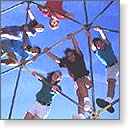| Help your child stay active |

Children are becoming less physically active than they were in the past. Many are staying indoors longer to watch TV and play videogames, and parents may be less eager to have their children running around outside due to fear of abduction or traffic accidents. As these trends have increased (and as diets have become less healthy), there has been a dangerous rise of obesity in children in recent years.
Childhood obesity should be taken very seriously -- many obese children develop type 2 diabetes, high cholesterol and blood pressure, sleep apnea, orthopedic problems, and other conditions that can last into adulthood.
The remedy for obesity is a nutritious diet and at least 60 minutes of moderate physical activity on most days of the week. Children may, however, need as much as 2 hours of physical activity a day. Adolescents may need 1.5 hours of physical activity a day.
Your child can jump, play basketball, participate in running games, bike, or find any other way to be active and have fun. For the health of your child, the Agency for Health Care Policy and Research makes the following suggestions to help develop good physical activity habits.
|
Remember, your children learn many of their habits from you. Try to set a good example and give them plenty of encouragement. You will be helping to give them a lifelong gift of good health.
The chances for heart disease may start to develop in children as early as elementary school. Children who exercise at least 2 hours a day, however, have a lower risk for heart disease than those who do not exercise. Adolescents who exercise at least 1.5 hours a day have a lower risk for heart disease.
References
Andersen LB, Harro M, Sardinha LB, et al. Physical activity and clustered cardiovascular risk in children: a cross-sectional study (The European Youth Heart Study). Lancet. Jul 22 2006;368(9532):299-304.
Child Health Guide: Put Prevention into Practice. Consumer Information. Agency for Health Care Policy and Research, Rockville, MD. http://www.ahrq.gov/ppip/ppchild.htm
Warburton DE, Nicol CW, Bredin SS. Prescribing exercise as preventive therapy. Cmaj. Mar 28 2006;174(7):961-974.
Reviewed By: Jeffrey Heit, MD, Internist with special emphasis on preventive health, fitness and nutrition, Philadelphia VA Medical Center, Philadelphia, PA. Review provided by VeriMed Healthcare Network. Also reviewed by David Zieve, MD, MHA, Medical Director, A.D.A.M., Inc.
